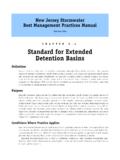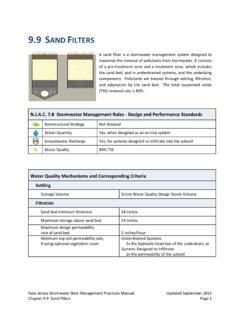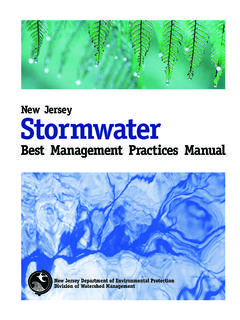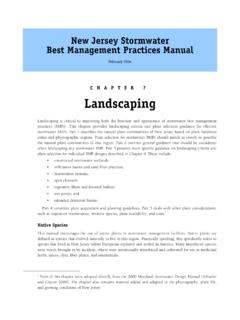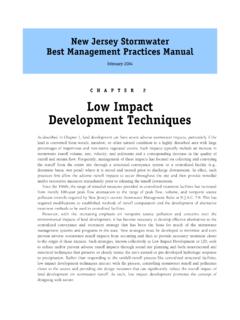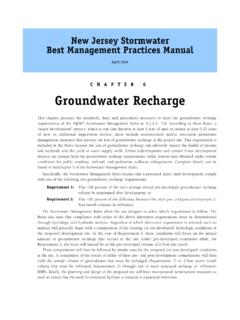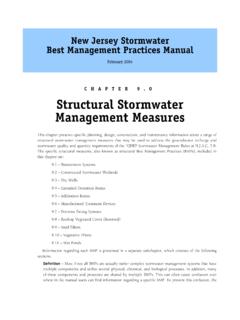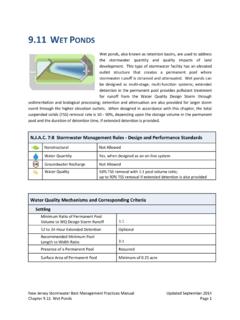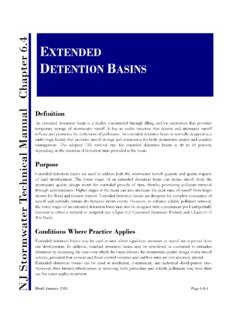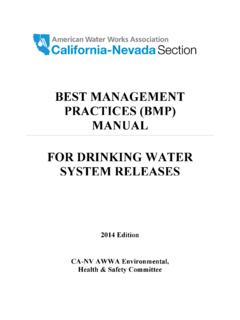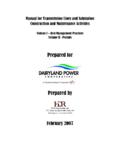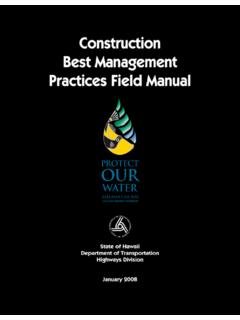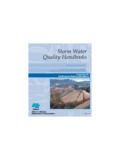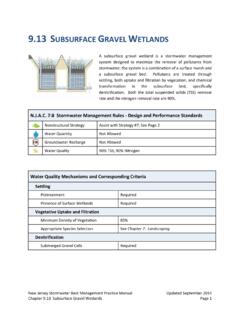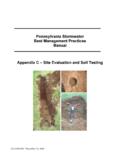Transcription of NJ Stormwater BMP Manual
1 New Jersey Stormwater Best Management Practices Manual Updated February 2016 Chapter 9. 3 Dry Wells Page 1 DRY WELLS Dry wells are subsurface Stormwater facilities that are used to collect and temporarily store runoff from clean rooftops; runoff is discharged through infiltration into the subsoil. Dry wells may be used to comply with the groundwater recharge design and performance standard of the Stormwater Management rules. Additionally, they may also be used to reduce the volume of clean, roof runoff. 7:8 Stormwater Management Rules - Design and Performance Standards Nonstructural Strategies Assist with Strategy #2; See Page 3 Water Quantity Not Allowed Groundwater Recharge Yes Water Quality Not Allowed Groundwater Recharge Mechanism and Corresponding Criteria Infiltration Maximum Drainage Area 1 acre Maximum Design Volume Water Quality Design Storm Volume Maximum Drain Time 72 hours, Using Slowest Design Permeability Rate Permeability Rate Factor of Safety 2 Minimum Design Permeability Rate of the Subsoil inches/hour Maximum Design Permeability Rate 10 inches/hour Soil Testing Consistent with Appendix E Required Minimum Distance between Dry Well Bottom and Seasonal High Water Table 2 feet New Jersey Stormwater Best Management Practices Manual Updated February 2016 Chapter 9.
2 3 Dry Wells Page 2 Introduction A dry well is a subsurface storage facility, consisting of either a structural chamber or an excavated vault that is only used to collect and temporarily store Stormwater runoff from rooftops; treatment of runoff from all other surfaces is prohibited. For more information and design criteria for other types of subsurface infiltration facilities that may be used to treat runoff from other surfaces, see Chapter : Infiltration Basins. Dry wells do not have a structural outlet; instead, outflow from the system is through infiltration into the subsoil. Dry wells may be used to meet the groundwater recharge design standard at 7 (a)2. Additionally, dry wells may be used to reduce the volume of clean, roof runoff generated by the Water Quality Design Storm. In dry wells, the rate of infiltration is affected by the permeability of the underlying soil, the distance separating the dry well bottom from the seasonal high water table (SHWT) and the area of the dry well bottom.
3 While loss of subsoil permeability through soil compaction is a concern, transport of dissolved pollutants by highly permeable subsoils is of equal concern. Although, in general, rooftops may not be a significant source of total suspended solids (TSS), they may be a source of nutrients and other contaminants. For example, in areas where birds tend to congregate, roofs may be a significant source of nutrients and bacteria; therefore, dry wells should not be sited in areas where there is a likelihood of high levels of rooftop pollutants. Additionally, due to the potential for groundwater contamination, the use of dry wells, and all Stormwater infiltration best management practices (BMPs), is prohibited in areas where high pollutant or sediment loading is anticipated. For more information regarding Stormwater runoff that may not be infiltrated, refer to 7 (a) However, this prohibition is limited only to areas onsite where this type of loading is expected.
4 Therefore, because dry wells collect only clean, roof runoff, they may be used on these types of sites provided the location of the dry well is not inconsistent with an NJDEP-approved remedial action work plan or landfill closure plan. Discharge from a dry well occurs through infiltration into the subsoil; therefore, they may not be used where their installation would create a significant risk of adverse hydraulic impacts. These impacts may include exacerbating a naturally or seasonally high water table so as to cause surficial ponding, flooding of basements, or interference with the proper operation of a subsurface sewage disposal system or other subsurface structure, or where their construction will compact the subsoil. Hydraulic impacts on the groundwater table must be assessed. For more information on groundwater mounding analysis, refer to the USGS Paper on Assessment of Impacts link on the Additional Guidance Documents page at Finally, a dry well must have a maintenance plan and, if privately owned, must be protected by easement, deed restriction, ordinance, or other legal measures that prevent its neglect, adverse alteration, or removal.
5 Applications The nonstructural Stormwater management strategies design standard in the Stormwater Management rules must be addressed for all major development, pursuant to 7 (a). The site evaluation for nonstructural strategies should consider all nine strategies. The design of a dry well can assist in maximizing the following strategy: New Jersey Stormwater Best Management Practices Manual Updated February 2016 Chapter 9. 3 Dry Wells Page 3 Strategy #2: The minimization of impervious surfaces and breaking up or disconnection of the flow of runoff over impervious surfaces. Dry wells may be used to meet the groundwater recharge requirements of the Stormwater Management rules. For more information on computing groundwater recharge, see Chapter 6: Groundwater Recharge. Dry wells may be used reduce the volume of clean, roof runoff generated by the Water Quality Design Storm.
6 For more information on calculating the water quality volume reduction, refer to page 7. Design Criteria Basic Requirements The following illustrations show the basic design criteria required for dry wells. The illustrations show possible configurations and flow paths and are not intended to limit the design. Additional information is provided on pages 5 through 8. Dry Well Basics - Profile and Cross-Section Views New Jersey Stormwater Best Management Practices Manual Updated February 2016 Chapter 9. 3 Dry Wells Page 4 Dry Well Basics Plan View Section through Inflow Pipe Inflow The use of dry wells is limited to the collection of clean, roof runoff and is prohibited in areas where high pollutant or sediment loading is anticipated. Maximum inflow drainage area: 1 acre. Storage Volume Dry wells are intended for small storm events; therefore, the maximum design volume is the volume generated by the Water Quality Design Storm.
7 All runoff volume in excess of the maximum design volume must be directed around the dry well by a diversion structure or device. No standing water may remain in the dry well 72 hours after a rain event in order to allow for sufficient storage for the next rain event. Additionally, storage in excess of 72 hours may render the dry well ineffective and may result in anaerobic conditions, odor, and both water quality and mosquito breeding issues. Infiltration may not be included in routing calculations for quantity control. Infiltration is defined as any discharge of runoff from the system into the subsoil and is sometimes referred to as exfiltration. New Jersey Stormwater Best Management Practices Manual Updated February 2016 Chapter 9. 3 Dry Wells Page 5 Physical Components The sides and top of the dry well must be completely lined with filter fabric in order to prohibit the migration of fines from the surrounding soil into the dry well, unless a structural chamber is provided.
8 The bottom of the dry well must be as level as possible in order to provide a uniform surface for infiltration. The seasonal high water table (SHWT) and bedrock must be at least 2 feet below the bottom of the dry well. Any stone fill within the dry well must be clean, washed aggregate between and inches in diameter. Perforated pipes must be anchored; a rebar anchor and a foot plate are required for vertical pipes. The first 12 inches of the perforated inflow pipe must be solid to facilitate the dispersion of runoff in the dry well. The horizontal inflow pipe must be disconnected from any overflow or outflow pipe or riser. An inspection port with removable cap is required to allow for inspection and maintenance. Permeability Rates The use of dry wells for Stormwater management is only feasible where the subsoil is sufficiently permeable to meet the minimum permeability rate below.
9 Soil tests are required at the exact location of the proposed system in order to confirm its ability to function as designed. The location of all soil testing must be consistent with Appendix E: Soil Testing Criteria in this Manual . Take note that permits may be required for soil testing in regulated areas, such as areas regulated under the Flood Hazard Area Control Act Rules ( 7:13), the Freshwater Wetlands Protection Act Rules ( 7:7A), the Coastal Zone Management Rules ( 7:7), and the Highlands Water Protection and Planning Rules ( 7:38). For dry wells associated with single-family residential development, only one soil boring is required per dry well. The testing of all permeability rates must be consistent with Appendix E: Soil Testing Criteria in this Manual , including the required information to be included in the soil logs, which can be found in section Soil Logs.
10 In accordance with 7 (j)1, Standards for Individual Subsurface Sewage Disposal Systems, the slowest tested permeability must be used for design purposes. Since the actual permeability rate may vary from soil testing results and may decrease over time, a factor of safety of 2 must be applied to the slowest tested permeability rate to determine the design permeability rate. The design permeability rate would then be used to New Jersey Stormwater Best Management Practices Manual Updated February 2016 Chapter 9. 3 Dry Wells Page 6 compute the system s drain time for the maximum design volume. The drain time is defined as the time it takes to fully infiltrate the maximum design storm runoff volume through the most hydraulically restrictive layer. The maximum design permeability rate of the subsoil is 10 inches/hour for any tested permeability of 20 inches/hour or more.

